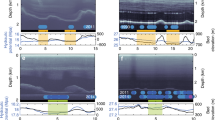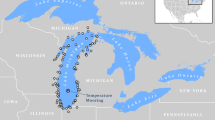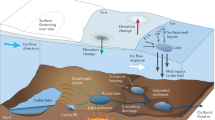Abstract
Titan, Saturn’s largest moon, hosts lakes and seas of liquid hydrocarbons at its poles1. General circulation models demonstrate that regional evaporation and precipitation rates of methane are likely to change with the seasons (Titan’s year is 29.5 Earth years) and evolve on a geological timescale (~105 Earth years)2,3,4. Cassini observations suggest shoreline recession at a few south polar lakes during local summer5, but similar seasonal changes have yet to be observed at the north pole where lakes are larger and more numerous6,7. We present three ‘phantom lakes’ that appear to be north polar surface liquids in winter observations by Cassini RADAR but that are inconsistent with lakes in infrared images obtained up to seven years later, after vernal equinox, suggesting that the liquids were removed in between. If this were the case, the phantom lakes could be interpreted as shallow ponds, with either a pure methane composition or a regolith porous enough to remove the less volatile ethane. These phantom lakes provide observational constraints on removal timescales for surface liquids at Titan’s north pole. The location, size and longevity of surface liquid reservoirs affect sediment processing7, seasonal weather8, climate evolution9, and even, perhaps, their habitability10. As solubility of the possible non-polar mixtures is generally low, short-lived lakes might be nutrient-poor10 and thus have low astrobiological potential.
This is a preview of subscription content, access via your institution
Access options
Access Nature and 54 other Nature Portfolio journals
Get Nature+, our best-value online-access subscription
$29.99 / 30 days
cancel any time
Subscribe to this journal
Receive 12 digital issues and online access to articles
$119.00 per year
only $9.92 per issue
Buy this article
- Purchase on Springer Link
- Instant access to full article PDF
Prices may be subject to local taxes which are calculated during checkout




Similar content being viewed by others
Data availability
All data presented here are available from the NASA Planetary Data System (https://pds-imaging.jpl.nasa.gov/portal/cassini_mission.html), except the NLDSAR swaths that are maintained by A.L. (http://cssnldsar.geophysx.org/). The data that support the plots within this paper are also available from the corresponding author upon reasonable request.
Change history
01 May 2019
In the version of this Article originally published, the following ‘Journal peer review information’ was missing: “Nature Astronomy thanks Marco Mastrogiuseppe and the other anonymous reviewer(s) for their contribution to the peer review of this work.” This statement has now been added.
References
Stofan, E. R. et al. The lakes of Titan. Nature 445, 61–64 (2007).
Lunine, J. I. & Lorenz, R. D. Rivers, lakes, dunes, and rain: crustal processes in Titan’s methane cycle. Annu. Rev. Earth Planet. Sci. 37, 299–320 (2009).
Lora, J. M., Lunine, J. I., Russell, J. L. & Hayes, A. G. Simulations of Titan’s paleoclimate. Icarus 243, 264–273 (2014).
Mitchell, J. L. & Lora, J. M. The climate of Titan. Annu. Rev. Earth. Planet. Sci. 44, 353–380 (2016).
Hayes, A. G. et al. Transient surface liquid in Titan’s polar regions from Cassini. Icarus 211, 655–671 (2011).
Hayes, A. et al. Hydrocarbon lakes on Titan: distribution and interaction with a porous regolith. Geophys. Res. Lett. 35, L9204 (2008).
Birch, S. P. D. et al. Geomorphologic mapping of Titan’s polar terrains: constraining surface processes and landscape evolution. Icarus 282, 214–236 (2017).
Tokano, T. Impact of seas/lakes on polar meteorology of Titan: simulation by a coupled GCM-Sea model. Icarus 204, 619–636 (2009).
Lora, J. M., Lunine, J. I. & Russell, J. L. GCM simulations of Titan’s middle and lower atmosphere and comparison to observations. Icarus 250, 516–528 (2015).
Tokano, T. Limnological structure of Titan’s hydrocarbon lakes and its astrobiological implication. Astrobiology 9, 147–164 (2009).
Mitri, G., Showman, A. P., Lunine, J. I. & Lorenz, R. D. Hydrocarbon lakes on Titan. Icarus 186, 385–394 (2007).
Newman, C. E., Richardson, M. I., Lian, Y. & Lee, C. Simulating Titan’s methane cycle with the TitanWRF general circulation model. Icarus 267, 106–134 (2016).
Turtle, E. P., Perry, J. E., Hayes, A. G. & McEwen, A. S. Shoreline retreat at Titan’s Ontario Lacus and Arrakis Planitia from Cassini Imaging Science Subsystem observations. Icarus 212, 957–959 (2011).
Cornet, T. et al. Edge detection applied to Cassini images reveals no measurable displacement of Ontario Lacus’ margin between 2005 and 2010. J. Geophys. Res. E 117, 7005 (2012).
Wye, L. C. et al. Electrical properties of Titan’s surface from Cassini RADAR scatterometer measurements. Icarus 188, 367–385 (2007).
Soderblom, J. M. et al. Modeling specular reflections from hydrocarbon lakes on Titan. Icarus 220, 744–751 (2012).
Rodriguez, S. et al. Impact of aerosols present in Titan’s atmosphere on the Cassini radar experiment. Icarus 164, 213–227 (2003).
Hofgartner, J. D. et al. Titan’s “Magic Islands”: transient features in a hydrocarbon sea. Icarus 271, 338–349 (2016).
Mastrogiuseppe, M. et al. The bathymetry of a Titan sea. Geophys. Res. Lett. 41, 1432–1437 (2014).
Mitchell, K. L., Barmatz, M. B., Jamieson, C. S., Lorenz, R. D. & Lunine, J. I. Laboratory measurements of cryogenic liquid alkane microwave absorptivity and implications for the composition of Ligeia Mare, Titan. Geophys. Res. Lett. 42, 1340–1345 (2015).
Lucas, A. et al. Insights into Titan’s geology and hydrology based on enhanced image processing of Cassini RADAR data. J. Geophys. Res. E 119, 2149–2166 (2014).
Paillou, P., Crapeau, M., Elachi, C., Wall, S. & Encrenaz, P. Models of synthetic aperture radar backscattering for bright flows and dark spots on Titan. J. Geophys. Res. E 111, E11 (2006).
Birch, S. et al. Raised rims around Titan’s sharp-edged depressions. Geophys. Res. Lett. https://doi.org/10.1029/2018GL078099 (2018).
Le Mouélic, S. et al. Dissipation of Titan’s north polar cloud at northern spring equinox. Planet. Space Sci. 60, 86–92 (2012).
Barnes, J. W. et al. Organic sedimentary deposits in Titan’s dry lakebeds: probable evaporite. Icarus 216, 136–140 (2011).
MacKenzie, S. M. et al. Evidence of Titan’s climate history from evaporite distribution. Icarus 243, 191–207 (2014).
Clark, R. N. et al. Detection and mapping of hydrocarbon deposits on Titan. J. Geophys. Res. E 115, 10005 (2010).
Lorenz, R. D., Niemann, H. B., Harpold, D. N., Way, S. H. & Zarnecki, J. C. Titan’s damp ground: constraints on Titan surface thermal properties from the temperature evolution of the Huygens GCMS inlet. Meteorit. Planet. Sci. 41, 1705–1714 (2006).
Turtle, E. P. et al. Titan’s meteorology over the Cassini mission: evidence for extensive subsurface methane reservoirs. Geophys. Res. Lett. 45, 5320–5328 (2018).
Elachi, C. et al. Radar: the Cassini Titan radar mapper. Space Sci. Rev. 115, 71–110 (2004).
Porco, C. C. et al. Cassini imaging science: instrument characteristics and anticipated scientific investigations at Saturn. Space Sci. Rev. 115, 363–497 (2004).
Tomasko, M. G. et al. A model of Titan’s aerosols based on measurements made inside the atmosphere. Planet. Space Sci. 56, 669–707 (2008).
Turtle, E. P. et al. Rapid and extensive surface changes near Titan’s equator: evidence of April showers. Science 331, 1414–1417 (2011).
Turtle, E. P. et al. Cassini imaging of Titan’s high-latitude lakes, clouds, and south-polar surface changes. Geophys. Res. Lett. 36, L02204 (2009).
Turtle, E. P. et al. Seasonal changes in Titan’s meteorology. Geophys. Res. Lett. 38, L03203 (2011).
Baines, K. H. et al. The atmospheres of Saturn and Titan in the near-infrared: first results of Cassini/VIMS. Earth Moon Planets 96, 119–147 (2005).
Brown, R. H. et al. Observations in the Saturn system during approach and orbital insertion, with Cassini’s visual and infrared mapping spectrometer (VIMS). Astron. Astrophys. 446, 707–716 (2006).
McCord, T. B. et al. Titan’s surface: search for spectral diversity and composition using the Cassini VIMS investigation. Icarus 194, 212–242 (2008).
MacKenzie, S. M. & Barnes, J. W. Compositional similarities and distinctions between Titan’s evaporitic terrains. Astrophys. J. 821, 17 (2016).
Barnes, J. W. et al. Global-scale surface spectral variations on Titan seen from Cassini/VIMS. Icarus 186, 242–258 (2007).
Le Mouélic, S. et al. Global mapping of Titan’ s surface using an empirical processing method for the atmospheric and photometric correction of Cassini/VIMS images. Planet. Space Sci. 73, 178–190 (2012).
Hirtzig, M. et al. Titan’s surface and atmosphere from Cassini/VIMS data with updated methane opacity. Icarus 226, 470–486 (2013).
Maltagliati, L. et al. Titan’s atmosphere as observed by Cassini/VIMS solar occultations: CH4, CO and evidence for C2H6 absorption. Icarus 248, 1–24 (2015).
Brossier, J. F. et al. Geological evolution of Titan’s equatorial regions: possible nature and origin of the dune material. J. Geophys. Res. E 123, 1089–1112 (2018).
Stephan, K. et al. Specular reflection on Titan: liquids in Kraken Mare. Geophys. Res. Lett. 37, L07104 (2010).
Barnes, J. W. et al. Wave constraints for Titan’s Jingpo Lacus and Kraken Mare from VIMS specular reflection lightcurves. Icarus 211, 722–731 (2011).
Barnes, J. W. et al. Cassini/VIMS observes rough surfaces on Titan’s Punga Mare in specular reflection. Planet. Sci. 3, 3 (2014).
Griffith, C. A. et al. The evolution of Titan’s mid-latitude clouds. Science 310, 474–477 (2005).
Barnes, J. W. et al. VIMS spectral mapping observations of Titan during the Cassini prime mission. Planet. Space Sci. 57, 1950–1962 (2009).
Rodriguez, S. et al. Global circulation as the main source of cloud activity on Titan. Nature 459, 678–682 (2009).
Rodriguez, S. et al. Titan’s cloud seasonal activity from winter to spring with Cassini/VIMS. Icarus 216, 89–110 (2011).
Minomura, M., Kuze, H. & Takeuchi, N. Adjacency effect in the atmospheric correction of satellite remote sensing data: evaluation of the influence of aerosol extinction profiles. Opt. Rev. 8, 133–141 (2001).
Hayes, A. G. The lakes and seas of Titan. Annu. Rev. Earth Planet. Sci. 44, 57–83 (2016).
Acknowledgements
This work was supported under the NASA Earth and Space Science Fellowship Program grant NNX14AO30H to S.M.M. J.W.B. acknowledges support from NASA Cassini Data Analysis Program NNX15AI77G. A.L. and S.R. acknowledge the financial support of the UnivEarthS Labex program at Sorbonne Paris Cité (ANR-10-LABX-0023 and ANR-11-IDEX-0005-02). S.R. is also supported by the French National Research Agency (ANR-APOSTIC-11-BS56-002, ANR-12-BS05-001-3/EXO-DUNES). Part of this work was carried out at the Jet Propulsion Laboratory, California Institute of Technology, under contract with NASA. Government sponsorship is acknowledged.
Author information
Authors and Affiliations
Contributions
S.M.M. led the procuring and analysis of the data and wrote the manuscript. J.W.B. assisted in all aspects of the analysis and writing. J.D.H. and S.P.D.B. contributed to the analysis of RADAR data. M.M.H. helped develop scattering models. A.L. wrote the code to produce NLDSAR and provided these data. All authors contributed to the discussion of these results. S.R. provided the radiative transfer model and contributed to their analysis. E.P.T. assisted in the calibration of ISS data and planned the ISS observations. C.S. planned the VIMS Titan observations.
Corresponding author
Ethics declarations
Competing interests
The authors declare no competing interests.
Additional information
Journal peer review information: Nature Astronomy thanks Marco Mastrogiuseppe and the other anonymous reviewer(s) for their contribution to the peer review of this work.
Publisher’s note: Springer Nature remains neutral with regard to jurisdictional claims in published maps and institutional affiliations.
Supplementary information
Supplemental Information
Supplementary Figures 1–6, Supplementary Text, Supplementary References
Rights and permissions
About this article
Cite this article
MacKenzie, S.M., Barnes, J.W., Hofgartner, J.D. et al. The case for seasonal surface changes at Titan’s lake district. Nat Astron 3, 506–510 (2019). https://doi.org/10.1038/s41550-018-0687-6
Received:
Accepted:
Published:
Issue Date:
DOI: https://doi.org/10.1038/s41550-018-0687-6
This article is cited by
-
Science goals and new mission concepts for future exploration of Titan’s atmosphere, geology and habitability: titan POlar scout/orbitEr and in situ lake lander and DrONe explorer (POSEIDON)
Experimental Astronomy (2022)
-
Wind, rain and methane on Titan
Nature Reviews Physics (2019)
-
Titan’s climate patterns and surface methane distribution due to the coupling of land hydrology and atmosphere
Nature Astronomy (2019)



